
An echinoderm is any member of the phylum Echinodermata of marine animals. The adults are recognizable by their radial symmetry, and include starfish, sea urchins, sand dollars, and sea cucumbers, as well as the sea lilies or "stone lilies". Adult echinoderms are found on the sea bed at every ocean depth, from the intertidal zone to the abyssal zone. The phylum contains about 7000 living species, making it the second-largest grouping of deuterostomes, after the chordates. Echinoderms are the largest phylum that has no freshwater or terrestrial members.

Starfish or sea stars are star-shaped echinoderms belonging to the class Asteroidea. Common usage frequently finds these names being also applied to ophiuroids, which are correctly referred to as brittle stars or basket stars. Starfish are also known as Asteroids due to being in the class Asteroidea. About 1,500 species of starfish occur on the seabed in all the world's oceans, from the tropics to frigid polar waters. They are found from the intertidal zone down to abyssal depths, 6,000 m (20,000 ft) below the surface.

Asterias is a genus of the Asteriidae family of sea stars. It includes several of the best-known species of sea stars, including the (Atlantic) common starfish, Asterias rubens, and the northern Pacific seastar, Asterias amurensis. The genus contains a total of eight species in all. All species have five arms and are native to shallow oceanic areas of cold to temperate parts of the Holarctic. These starfish have planktonic larvae. Asterias amurensis is an invasive species in Australia and can in some years become a pest in the Japanese mariculture industry.
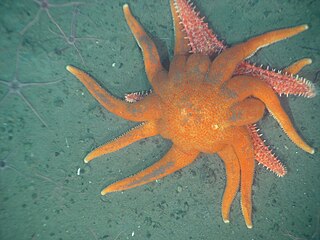
The Valvatida are an order of starfish in the class Asteroidea, which contains 695 species in 172 genera in 17 families.

The Echinasteridae are a family of starfish in the monotypic order Spinulosida. The family includes eight genera and about 133 species found on the seabed in various habitats around the world.

Coscinasterias is a genus of sea stars of the family Asteriidae.
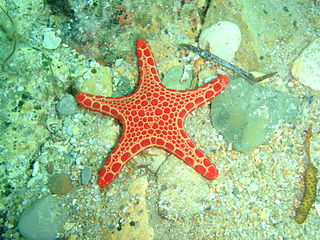
Goniasteridae constitute the largest family of sea stars, included in the order Valvatida. They are mostly deep-dwelling species, but the family also include several colorful shallow tropical species.
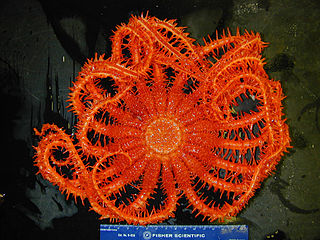
The Brisingids are deep-sea-dwelling starfish in the order Brisingida.

Luidia is a genus of starfish in the family Luidiidae in which it is the only genus. Species of the family have a cosmopolitan distribution.

Linckia multifora is a variously colored starfish in the family Ophidiasteridae that is found in the Indian Ocean and Red Sea. Its common names include the Dalmatian Linckia, mottled Linckia, spotted Linckia, multicolor sea star and multi-pore sea star.
Asexual reproduction in starfish takes place by fission or through autotomy of arms. In fission, the central disc breaks into two pieces and each portion then regenerates the missing parts. In autotomy, an arm is shed with part of the central disc attached, which continues to live independently as a "comet", eventually growing a new set of arms. Although almost all sea stars can regenerate their limbs, only a select few sea star species are able to reproduce in these ways.
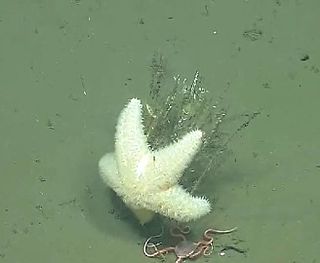
Poraniopsis is a genus of starfish in the family Poraniidae in the order Valvatida. Poraniopsis echinaster is the type species.

Leptasterias hexactis is a species of starfish in the family Asteriidae, commonly known as the six-rayed star. It is found in the intertidal zone of the western seaboard of the United States. It is a predator and is unusual among starfish in that it broods its eggs and young.
Stylasterias is a genus of starfish in the family Asteriidae. Stylasterias forreri, the velcro star, is the only species in the genus. It is found on the Pacific coast of Canada and the United States.

The Brisingidae are a family of starfish found only in the deep sea. They inhabit both the Atlantic and Pacific Oceans at abyssal depths, and also occur in the Southern Ocean and around Antarctica at slightly shallower depths.
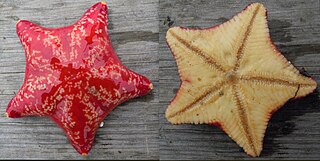
Poraniidae is a family of starfishes in the order Valvatida.

The Freyellidae are a family of deep-sea-dwelling starfish. It is one of two families in the order Brisingida. The majority of species in this family are found in Antarctic waters and near Australia. Other species have been found near New Zealand and the United States.

Marthasterias is a genus of starfish in the family Asteriidae. It is monotypic and the only species in the genus is Marthasterias glacialis, commonly known as the spiny starfish. It is native to the eastern Atlantic Ocean.
Brisinga is a genus of starfish in the family Brisingidae. The species in this genus are primarily found in deep sea habitats.
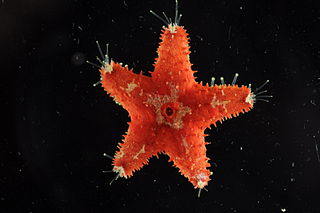
Euretaster insignis, commonly known as the striking sea star, is a species of starfish in the family Pterasteridae found in the central west Pacific Ocean. It is one of only three species in the order Velatida to be found in shallow water in the tropics. The young are brooded in a cavity underneath a "supradorsal" membrane.

















